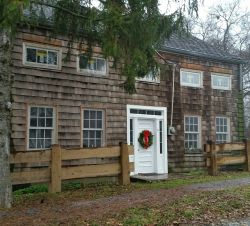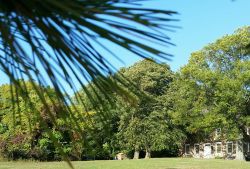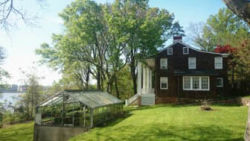Conference House Park
Monarch Butterflies in New York City - Conference House Park
The monarch butterfly (Danaus plexippus) may seem to be one of the most delicate creatures alive. But despite its frail appearance, every year the monarch makes a long and perilous journey thousands of miles south to escape the harsh winters of the North. While on this journey, the monarch can often be seen on the south-facing shorelines of Conference House Park.
The monarch butterfly begins its migration in September and travels for 30-45 days. Monarchs originating east of the Rocky Mountains and as far north as Canada make their way to the quiet, cool mountains of the Transvolcanic Region in central Mexico, about 60 miles west of Mexico City in the state of Michoacan. Migrating monarchs can be observed along the City’s beaches and coastal parks. Monarchs from New York City travel as much as 2,100 miles, averaging 50 miles a day, to reach their destination by the end of October. Resting in the chilly treetops, the butterflies hibernate for four months, covering oyamel fir trees (Abies religiosa) in thick layers that resemble black and orange leaves. During this period, the monarchs sit quietly with their wings folded, living off of fat reserves.
When the weather warms, usually in March, the monarchs come out of hibernation and mate. After mating, they begin their return trip to the southern United States. There they lay their eggs on milkweed (Asclepiadaceae) plants and die, entrusting their offspring to fend for themselves. The milkweed is an important food source for monarch caterpillars. As the larvae gorge themselves on the leaves, they accumulate the milkweed’s toxic cardiac glycosides and become poisonous to birds and other predators. An unknowing bird that tries to eat a monarch soon finds out how distasteful these butterflies are and vomits it up, and the bird learns to avoid the monarch’s distinctive colors. Many other species of butterfly, such as the harmless viceroy (Limenitis archippus), mimic the colors of the monarch with the hopes that predators will avoid them too.
After about a month of feeding, the caterpillars pupate and metamorphose into adults. The adult monarchs continue the journey north and also lay eggs. By late June, the third generation of monarchs reaches New York City, and, by August, their offspring reach Canada. This fourth generation spends its time storing energy from nectar so they can make the long journey to Mexico in September.
How monarchs are able to navigate their way across unfamiliar terrain is unknown. Some speculate that the butterflies rely on the earth’s magnetic field for guidance, while others believe that the directions are embedded into the monarch’s genetic code. Whatever the reason, the monarch remains one of the City’s most beautiful and enchanting sights. Visitors to Conference House Park can often enjoy a glimpse of monarch butterflies as they travel through the city.
Check out your park's Vital Signs
Clean & Safe
Green & Resilient
Empowered & Engaged Users
Share your feedback or learn more about how this park is part of a
Vital Park System
Downloads
Contacts
Visitors Center: (718) 227-1403










